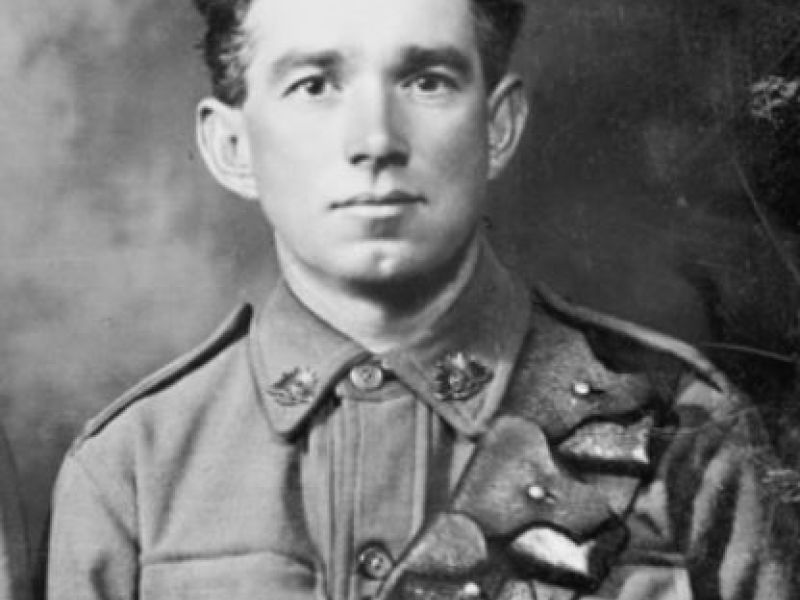John (Jack) McMahon
Jack was born in 1889 at Sandy Creek in Victoria. He was one of eleven children of John and Mary (née McGrath) McMahon.
He enlisted on the 30th of July, 1915 at Melbourne, Victoria. His medical examination, which took place one week earlier in Wodonga, passed the 26 year-old labourer as fit for active service. He was allocated the Regimental Number 3203 and placed in the 7th Reinforcements for the 22nd Battalion. Following eight weeks training at Broadmeadows Camp he was transferred to the camp at Seymour in Victoria and taken on strength with the 22nd Battlion.
By the time that Jack embarked on HMAT A73 Commonwealth on the 26th of November, 1915, at Melbourne, the 22nd Battalion had been fighting at Gallipoli for almost two months. They would serve on the Peninsula until the final evacuation in December of 1915, at which time they were withdrawn to Egypt. Here, they were brought back up to strength with reinforcement, one of whom was Jack.
In early February of 1916, Jack was transferred to the 58th Battalion at Ismailia in Egypt. This battalion was raised as part of an expansion program of the AIF. The 1st Division and 4th Infantry Brigade were split in two and their constituent battalions divided. These new battalions, also referred to as ‘pup’ battalions, were brought up to strength with recently arrived reinforcements from Australia.
On the 7th of February, Jack reported sick to the 15th Australia Field Ambulance. The following day he was admitted to the 2nd Australian Casualty Clearing Station where he was diagnosed as having “theaycardia”. A search revealed that there was no such condition and it could have been a misspelling of tachycardia, a condition where the hearts beats much faster than normal. Jack was discharged from hospital the following day.
Following two months training in Egypt the battalion embarked on HT Kalyan at Alexandria and proceeded to join the British Expeditionary Forces on the Western Front. The 58th arrived in France in time to take part in its first major battle, Fromelles. There is no record describing Jacks thoughts and feelings as he went into battle for the first time. Fromelles was a disaster. In 24 hours the 5th Australian Division suffered over 5500 casualties, almost 2000 of those being killed of died or wounds. The 58th lost almost a third of its strength. The battalion continued to man the front in the Fromelles sector for a further two months.
The winter of 1916/17 was one of the coldest on record. In late November Jack reported to the 36th Casualty Clearing Station suffering from trench foot. The wet and muddy conditions on the battlefield resulted in many troops suffering from this conidtion. In extreme cases it became necessary to amputate the affected foot. Jack was evacuated to England on HT Carisbrook and then admitted to the Royal Victoria Military Hospital at Netley, near Southamption in Hampshire. Jack would not rejoin his battalion for another seven months.
Jack returned in time to participate in the battle at Polygon Wood in the Ypres sector in Belgium. This time the 4th and 5th Australain Divisions would take the lead in the ANZAC sector. Advancing behind a heavy artillery barrage the Australians secured most of their objectives without difficulty. The battle still cost the Australians 5770 casualties.
On the 24th of April, 1918, the battalion took part in the Second Battle of Viller-Bretonneux. This battle would become notable for being the first occasion in which tank-on-tank battles took place. Villers-Bretonneux had, three weeks earlie, been captured by the Germans from British troops. It was the 58th Battalions role to take over the portion of the line that was vacated by the 57th Battalion as it participated in the counter-attack upon the village. Although the battalion was the Brigade reserve, and therefore didn’t take part in the actual attack, it suffered casualties from the intense artillery barrages brought down by the Germans. At the end of the battle on the 27th of April, Jack was posted as being wounded and missing in action. A court of inquiry held in March of 1919 concluded that he had been killed in action.
Three of John’s and Mary’s children enlisted and served overseas. Only one came back. There were no photographs of headstones for the parents and family to grieve over as both Jack and his younger brother James had no grave. They had simply vanished on the battlefield. As late as August of 1922, John and Mary still hoped that their boy’s remains would be found. A letter, written by John and letter addressed to Base Records in Melbourne, describes a parent’s hope.
“Sandy Ck
Via Huon
Victoria
16.8.22
To
Officer in charge Base Records
Dear Sir,
With ref to the graves of my two sons Priv James McMahon No 3202. (7th Battalion) Priv Jack McMahon No 3203 (57 Battalion) will you kindly inform me if you have found any trace of these I have a friend going to France shortly on a trip, & would like very much to have the numbers if possible. Hoping you will advise me as soon as possible.
I remain
Yours faithfully,
John McMahon”
The reply, which came two weeks later, informed John that no information had been forthcoming and that it was advised that if his friend visited France then to call on the Australian Graves Services located at Australia House in London.
Jack has no known grave. He is remembered at the Australian War Memorial Roll of Honour, the Villers-Bretonneux Memorial (Australian National Memorial), and the Sandy Creek Cemetery World War 1 Veterans Memorial Plaque. For his service he was awarded the British War Medal and the Victory Medal.

 Stephen Learmonth
Stephen Learmonth